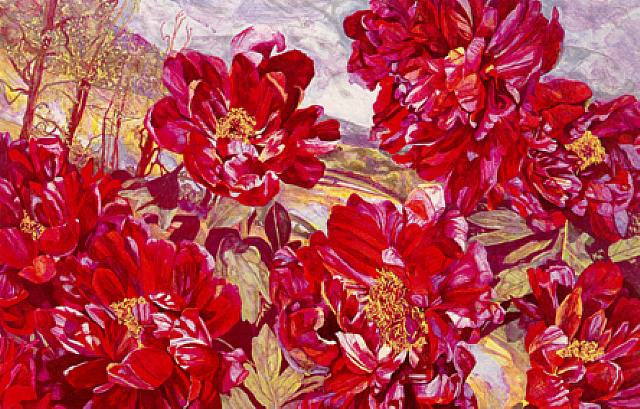Patricia Tobacco Forrester ROYAL FLASH, Litograph, ed. 75, 1990
THE CONDITIONED VIEW: Limited graphic shows the artist´s different approach to their subjects and the right chosen materials. Creating forms and aspects of small and wide appearances and phenomenas in a subtil and handsomely way they give us impressions of their life sensibility, passion and obsession. Patricia Tobacco Forrester, Rebecca Horn, Annie Retivat, Brigitte Coudrain, Helga Philipp, Karl Korab, Kumi SugaĂŻÂ …
Patricia Tobacco Forrester, 70, a watercolorist whose vibrant and intricate paintings of nature brought her nationwide critical acclaim, died March 16 at her home in the District.
A spokeswoman for the D.C. medical examiner said the cause of death ahd not been determined.
Ms. Forrester’s art — brilliantly colored flowers and lush vegetation on gargantuan sheets of paper sometimes six feet tall — has been exhibited in museums around the world.
A number of her works are part of the permanent collections at the Corcoran Gallery of Art, the Smithsonian American Art Museum, the Brooklyn Museum in New York, the Art Institute of Chicago and the British Museum in London.
Ms. Forrester, who studied art with Chuck Close and Janet Fish at Yale University, spent much of her youth tending to the asparagus, cucumbers and tobacco on her family’s Massachusetts farm. With an imbued appreciation for plant life, she once said her goal as an artist was to capture nature’s vitality on paper.
“The subject of my work is always growth,” Ms. Forrester told Watercolor magazine in 2009. “How trees and plants bulge and stretch and open.”
She traveled the world with her brushes. A plein air artist, she hiked deep into the jungles of Costa Rica, Vietnam and Singapore to paint her landscapes.
The results of her often sweat-logged efforts helped her earn broad critical recognition. In 1981, New York Times art critic Hilton Kramer said Ms. Forrester “brought a fresh eye and an accomplished technique” to watercolor and a “vein of lyric feeling that is obviously felt as a personal imperative.”
Kramer also noted that Ms. Forrester possessed a “certain tender feeling that lives on easy terms with her rigorous sense of pictorial form.”
Washington Post critic Benjamin Forgey wrote in 1984 that Ms. Forrester’s “images of trees, flowers and grasses, so strong in color, hold the wall like bold abstract paintings.”
“At the same time,” Forgey said, “her composition sense is very strong, so that the complexity of pattern and color is held in tight, muscular check. The results please both mind and senses.”
Patricia Ann Tobacco was born Sept. 17, 1940, in Northampton, Mass. She grew up in nearby Hatfield. When her grandfather arrived at Ellis Island, the clerk changed his last name from Tobczynski to Tobacco.
Ms. Forrester was an art student under Leonard Baskin at Smith College and, after graduating in 1962, enrolled at Yale University, where she received a bachelor of fine arts in 1963 and master of fine arts in 1965. Two years later, she was awarded a Guggenheim Fellowship.
Her marriages to Alex Forrester and Paul Ekman ended in divorce. Survivors include a brother.
Early in her career, Ms. Forrester spent serveral years in the San Francisco area. After marrying Ekman, a renowned psychologist, she accompanied him on trips to Hawaii and Micronesia.
While he did field research on the facial expressions of emotions across cultures, she took her easel and paints into the wilderness.
She moved to the Washington area in the early 1980s and frequently painted landscapes around the District, including at the National Arboretum.
“I think I know almost every tree and flower there,” she said in 2009.
While Ms. Forrester began her career in etchings and oils, she preferred the spontaneity of watercolor.
“It can be finely controlled yet also allowed to explode in swifts and rivulets,” she told Watercolor magazine. “The accidental nature of watercolor — the fact that paint moves across the paper — is my partner in the work.”
Brigitte Coudrain was born 26 years ago in Paris. She lives there still. In 1954, after completing her preliminary studies, she entered the atelier-Ă©cole of the well-known engraver, Friedlaender. There she acquired that astonishing knowledge of the techniques of her art which is the mark of all Friedlaender’s students. The limited selection of her work which follows does not, unfortunately, show the full range of her virtuosity with
the medium. But what it does show—more perhaps than her dusky undulating landscapes or her fine figuring of strange plants in the colors and frailty of pressed flowers—is the distinctive quality of an imagination which has not been blurred by the gratuitous elaboration of a well-learned craft. The technique of inflicting tiny violences through wax on copper or zinc, then brushing acid into the wounds seems on the contrary, the supreme refinement of a delicate viciousness.),

